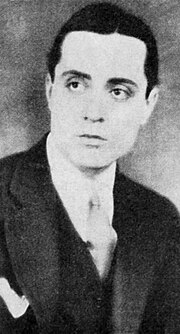Manuel Granada

Manuel Granada (6 November 1896 - 30 January 1974) was an Argentine actor who appeared in American, Spanish, Argentine and Mexican films. For the first half of his career, he worked under the names Paul Ellis and Manuel Granado.
Granada was born Benjamin Ingenito [1] in Buenos Aires on November 6, 1896. He made his film debut in the Metro-Goldwyn film The Bandolero in 1924 under the name Manuel Granado.[2] He was signed to a contract by Louis B. Mayer and listed as a Metro-Goldwyn principal player in the same year.[3][4] An April 1925 article by Harry Carr for Motion Picture dubbed him 'Hollywood's New Sheik.'[5] Like other Latino actors in silent-era Hollywood, he had adapted a WASPy screen name, which stood in contrast to his dark features, a look that was popular at the time. Despite this, he was still cast almost exclusively as secondary ethnic characters, unlike his contemporaries in silent-era Hollywood like Gilbert Roland and Barry Norton (a fellow Argentine). He was singled out for praise by The Los Angeles Herald Examiner and other Los Angeles newspapers after the 1926 premiere of The Dancer of Paris.[6]
The coming of sound found Paul Ellis relegated to bit parts, though he did secure some substantial roles in Spanish-language versions of English-language films such as La Voluntad del muerto (1930). In 1930, he also wrote and appeared in the film Alma De Gaucho.[7][8][9] Ellis also appeared in Charros, gauchos y manolas, a musical directed by Xavier Cugat.[10] These films were usually released in Spanish-language territories only. He continued to appear in American films for another ten years, mostly in brief uncredited roles, though he is remembered by some for his appearance in Marihuana (1936), which retains a small cult following. He made his last American film, Whistling in the Dark, in 1941.[11]
Still using the name Paul Ellis, Granada next shows up in films in 1947 in Argentina, and continued to appear in films in Argentina. He appeared in the Mexican/Argentine co-production La Tierra del Fuego se apaga.
Selected filmography
- The Bandolero (1924)[2]
- Pretty Ladies (1925)
- The Pace that Thrills (1925)[12]
- The Dancer from Paris (1926)[13][14]
- Three Hours (1927)[15]
- The Younger Generation (1929)
- In Old California (1929)
- The Bridge of San Luis Rey (1929)[7]
- Charros, gauchos y manolas (1930)[10]
- Alma de Gaucho (1930)[7]
- La Voluntad del muerto (1930)
- The Common Law (1931)[16]
- El pasado acusa (1931)
- Hombres de mi vida (1932)
- Soñadores de gloria (1932)
- No Man of Her Own (1932)[17]
- Contrabando (1932)
- Laughing at Life (1933)
- The Woman Condemned (1934)
- One Night of Love (1934)
- The Merry Widow (1934)
- Women Must Dress (1935)
- Captured in Chinatown (1935)
- Reckless (1935)
- Tailspin Tommy in the Great Air Mystery (1935)[18]
- Rip Roaring Riley (1935)
- Never Too Late (1935)
- Wife vs. Secretary (1936)
- Marihuana (1936)
- Murder at Glen Athol (1936)
- Heroes of the Alamo (1937)
- El Trovador de la Radio (1938)[19]
- The Buccaneer (1938)
- Bachelor Father (1939)[20]
- Di que me quieres (1939)
- Ninotchka (1939)
- Rose of Washington Square (1939)
- Arizona Gang Busters (1940)
- Down Argentine Way (1940)
- They Met in Argentina (1941)
- Blood and Sand (1941)
- Too Many Blondes (1941)
- Desperate Cargo (1941)
- Whistling in the Dark (1941)
- La senda oscura (1947)
- El precio de una vida (1947)
- Derecho viejo (1951)
- Rebelión en los llanos (1953)
- Stella Maris (1953)
- El pescador de coplas (1954)
- La Tierra del Fuego se apaga (1955)
References
- ^ Cunninghma, James (November 15, 1934). "Asides & Interludes". Motion Picture Herald. Quigley Publishing: 15. Retrieved October 25, 2017.
- ^ a b Metro-Goldwyn Pictures Presentation Book (Australia). Metro-Goldwyn Pictures. 1924. Retrieved October 24, 2017.
- ^ "Sign Helena D'Algy". Moving Picture World. Chalmers Publishing Company: 378. October 18, 1924. Retrieved October 24, 2017.
- ^ Metro-Goldwyn Pictures Presentation Book (Australia). Metro-Goldwyn Pictures. 1924. Retrieved October 24, 2017.
- ^ Carr, Harry (April 1925). "Hollywood's New Sheik". Motion Picture. Brewster Publications: 25. Retrieved October 24, 2017.
- ^ "Paul Ellis Praised by L.A. Critics". Moving Picture World. Chalmers Publishing Company: 301. May 22, 1926. Retrieved October 24, 2017.
- ^ a b c "What Is There In A Name-He Changed His And Luck Seemed To Follow". Hollywood Filmograph. Hollywood Filmograph: 24. May 3, 1920. Retrieved October 24, 2017.
- ^ "Alma De Gaucho". TCM database. 1930. Retrieved October 24, 2017.
- ^ "'Alma Gaucha', A Spanish Picture, Near Completion". Hollywood Filmograph. Hollywood Filmograph: 12. April 26, 1930. Retrieved October 24, 2017.
- ^ a b "Charros, gauchos y manolas". TCM database. 1930. Retrieved October 24, 2017.
- ^ "Whistling in the Dark". TCM database. 1941. Retrieved October 24, 2017.
- ^ "Hollywood Happenings". The Film Daily. Wid's: 7. September 4, 1925. Retrieved October 24, 2017.
- ^ "Ad for the 1926 film "The Dancer of Paris"". Motion Picture News. Rothacker Films: back cover. March 13, 1926. Retrieved October 24, 2017.
- ^ "The Dancer of Paris". Motion Picture News. Motion Picture News: 1211. March 13, 1926. Retrieved October 24, 2017.
- ^ The Film Daily Year Book. Wid's. 1928. p. 369. Retrieved October 24, 2017.
- ^ "Sales Angles on 'The Common Law'". Motion Picture Herald. Quigley Publishing: 32. July 25, 1931. Retrieved October 24, 2017.
- ^ "'No Man of Her Own'". Picture Play. Street and Smith: 60. April 1933. Retrieved October 24, 2017.
- ^ "'Tailspin Tommy' Sequel Starts". Universal Weekly. Universal Pictures: 23. August 17, 1935. Retrieved October 24, 2017.
- ^ "Tito Guizar's 'El Trovador de la Radio' Acclaimed Spanish Triumph". Paramount's International News. Paramount Pictures: 5. December 1938. Retrieved October 24, 2017.
- ^ "Esta Vez Hay Que Advinarlo". Cine Mundial. Paramount: 158. April 1939. Retrieved October 24, 2017.
